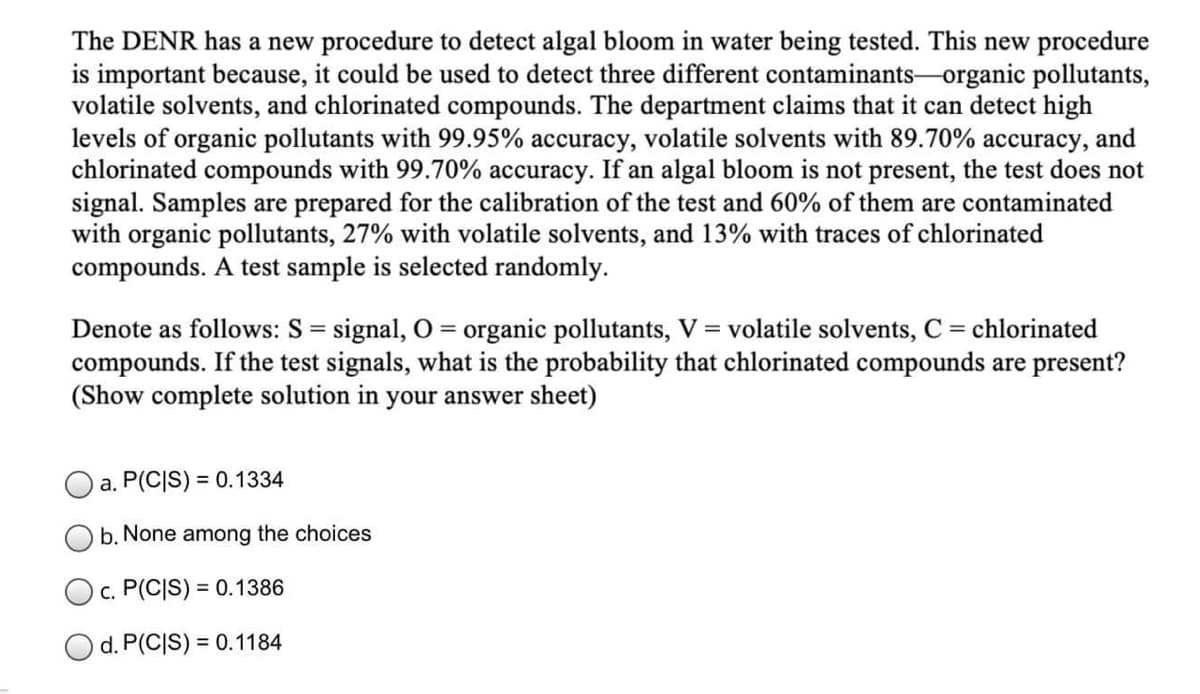The DENR has a new procedure to detect algal bloom in water being tested. This new procedure is important because, it could be used to detect three different contaminants-organic pollutants, volatile solvents, and chlorinated compounds. The department claims that it can detect high levels of organic pollutants with 99.95% accuracy, volatile solvents with 89.70% accuracy, and chlorinated compounds with 99.70% accuracy. If an algal bloom is not present, the test does not signal. Samples are prepared for the calibration of the test and 60% of them are contaminated with organic pollutants, 27% with volatile solvents, and 13% with traces of chlorinated compounds. A test sample is selected randomly. Denote as follows: S = signal, O = organic pollutants, V = volatile solvents, C = chlorinated compounds. If the test signals, what is the probability that chlorinated compounds are present? (Show complete solution in your answer sheet) O a. P(C|S) = 0.1334 b. None among the choices Oc. P(C|S) = 0.1386 d. P(C|S) = 0.1184
The DENR has a new procedure to detect algal bloom in water being tested. This new procedure is important because, it could be used to detect three different contaminants-organic pollutants, volatile solvents, and chlorinated compounds. The department claims that it can detect high levels of organic pollutants with 99.95% accuracy, volatile solvents with 89.70% accuracy, and chlorinated compounds with 99.70% accuracy. If an algal bloom is not present, the test does not signal. Samples are prepared for the calibration of the test and 60% of them are contaminated with organic pollutants, 27% with volatile solvents, and 13% with traces of chlorinated compounds. A test sample is selected randomly. Denote as follows: S = signal, O = organic pollutants, V = volatile solvents, C = chlorinated compounds. If the test signals, what is the probability that chlorinated compounds are present? (Show complete solution in your answer sheet) O a. P(C|S) = 0.1334 b. None among the choices Oc. P(C|S) = 0.1386 d. P(C|S) = 0.1184
Glencoe Algebra 1, Student Edition, 9780079039897, 0079039898, 2018
18th Edition
ISBN:9780079039897
Author:Carter
Publisher:Carter
Chapter10: Statistics
Section10.1: Measures Of Center
Problem 9PPS
Related questions
Question
Please show complete solution.

Transcribed Image Text:The DENR has a new procedure to detect algal bloom in water being tested. This new procedure
is important because, it could be used to detect three different contaminants-organic pollutants,
volatile solvents, and chlorinated compounds. The department claims that it can detect high
levels of organic pollutants with 99.95% accuracy, volatile solvents with 89.70% accuracy, and
chlorinated compounds with 99.70% accuracy. If an algal bloom is not present, the test does not
signal. Samples are prepared for the calibration of the test and 60% of them are contaminated
with organic pollutants, 27% with volatile solvents, and 13% with traces of chlorinated
compounds. A test sample is selected randomly.
Denote as follows: S = signal, O = organic pollutants, V = volatile solvents, C = chlorinated
compounds. If the test signals, what is the probability that chlorinated compounds are present?
(Show complete solution in your answer sheet)
a. P(C|S) = 0.1334
b. None among the choices
Oc. P(C|S) = 0.1386
O d. P(C|S) = 0.1184
Expert Solution
This question has been solved!
Explore an expertly crafted, step-by-step solution for a thorough understanding of key concepts.
Step by step
Solved in 2 steps with 2 images

Recommended textbooks for you

Glencoe Algebra 1, Student Edition, 9780079039897…
Algebra
ISBN:
9780079039897
Author:
Carter
Publisher:
McGraw Hill

Glencoe Algebra 1, Student Edition, 9780079039897…
Algebra
ISBN:
9780079039897
Author:
Carter
Publisher:
McGraw Hill